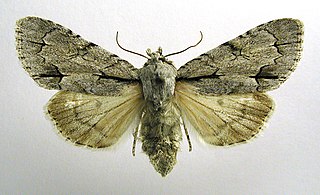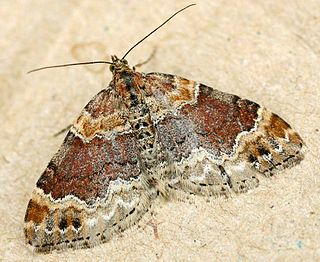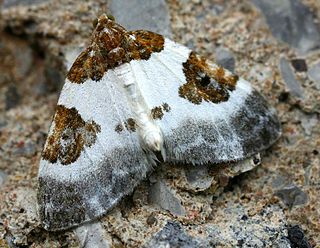
The willow beauty is a moth of the family Geometridae. It is a common species of Europe and adjacent regions. While it is found widely throughout Scandinavian countries, which have a maritime climate, it is absent from parts of the former USSR which are at the same latitude but have a more continental climate.

The dark dagger is a moth of the family Noctuidae. The species was first described by Michael Denis and Ignaz Schiffermüller in 1775. It is distributed throughout Europe, Turkey, the Near East, the European part of Russia, southern Siberia, the Ural, the Russian Far East, the Korean Peninsula, China and Japan (Hokkaido).

Boloria is a brush-footed butterfly (Nymphalidae) genus. Clossiana is usually included with it nowadays, though some authors still consider it distinct and it seems to warrant recognition as a subgenus at least.

Xanthorhoe spadicearia, the red twin-spot carpet, is a moth of the genus Xanthorhoe in the family Geometridae. The species was first described by Michael Denis and Ignaz Schiffermüller in 1775.

Lomographa temerata, the clouded silver, is a moth of the family Geometridae. The species is found in Asia and Europe and was first described by Michael Denis and Ignaz Schiffermüller in 1775.

Plemyria rubiginata, the blue-bordered carpet, is a moth of the family Geometridae found in Europe and across the Palearctic. The moth was first described by the Austrian lepidopterists Michael Denis and Ignaz Schiffermüller in 1775.

Gillmeria ochrodactyla is a moth of the family Pterophoridae found in Asia and Europe. It was first described by the Austrian entomologists, Michael Denis & Ignaz Schiffermüller in 1775.

Cnaemidophorus rhododactyla, also known as the rose plume moth, is a moth of the superfamily Pterophoroidea, family Pterophoridae. It is found in the Northern Hemisphere, except for Greenland, Southeast Asia, and most of North Africa. It was first described by Michael Denis and Ignaz Schiffermüller, 1775.

Brenthis daphne, the marbled fritillary, is a butterfly of the family Nymphalidae.

Catephia alchymista, the white underwing or alchymist, is a moth in the family Erebidae found in Asia, Europe and North Africa. The species was first described by Michael Denis and Ignaz Schiffermüller in 1775.

Diarsia brunnea, the purple clay, is a moth of the family Noctuidae. The species was first described by Michael Denis and Ignaz Schiffermüller in 1775. It is found in most of Europe, east to Transcaucasia, the Caucasus, central Asia, Siberia, the Kuriles, Amur, Ussuri, Sakhalin, Korea, Japan, and China, including China’s Tibet region.

Entephria caesiata, the grey mountain carpet, is a moth of the family Geometridae. The species was first described by Michael Denis and Ignaz Schiffermüller in 1775. It is found in the mountainous areas of Europe, the Caucasus, Asia Minor, Armenia, Russia, Russian Far East, Siberia, northern Mongolia, Sakhalin and Honshū in Japan.

Apamea furva, the confused, is a moth of the family Noctuidae. The species was first described by Michael Denis and Ignaz Schiffermüller in 1775. It is found throughout Europe. In southwestern Europe it is primarily montane. It is found as far north as the Arctic Circle. From Europe its range extends to Siberia, Turkey, Iran, Kyrgyzstan, Mongolia and Xinjiang in China.

Platyptilia calodactyla is a moth of the family Pterophoridae found in Asia and Europe. It was first described by the Austrian entomologists, Michael Denis & Ignaz Schiffermüller in 1775.

Merrifieldia leucodactyla, also known as the thyme plume, is a moth of the family Pterophoridae, and is known from most of Europe, as well as North Africa and Asia Minor. It was first described by the Austrian lepidopterists, Michael Denis and Ignaz Schiffermüller in 1775).

Lithostege griseata, the grey carpet, is a moth of the family Geometridae. The species was first described by Michael Denis and Ignaz Schiffermüller in 1775. It is found in most of Europe, from Great Britain and the Iberian Peninsula to the Ural Mountains and further east to central Asia and Transcaucasia, Asia Minor and the Near East.

Pareulype berberata, the barberry carpet moth, is a moth of the family Geometridae. The species was first described by Austrian lepidopterists, Michael Denis and Ignaz Schiffermüller in 1775. The moth is found in Africa, Asia and Europe.

Pediasia luteella is a species of moth in the family Crambidae. It was described by Michael Denis and Ignaz Schiffermüller in 1775. It is found in most of Europe. In the east, the range extends to Central Asia, the northern Caucasus, Transcaucasia, southern Siberia and Mongolia.




















